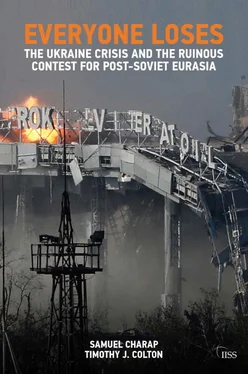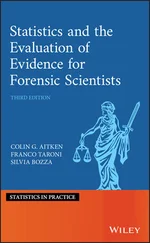After Western partners demanded specifics regarding Medvedev’s proposal, Russia published a draft treaty in November 2009. [83] ‘The Draft of the European Security Treaty’, 29 November 2009, http://en.kremlin.ru/events/president/news/6152 .
The document, while grounded in widely accepted principles like respect for territorial integrity and political independence, and the renunciation of the use of force, was deeply flawed. It was a legally binding treaty, the most weighty of all international agreements, which tend to come after a build-up of less formal arrangements that help generate support among domestic constituencies needed for ratification. It tackled core disagreements by creating new bureaucracies and crisis-response mechanisms. It also included provisions that would have obliged all states and existing organisations (including the EU and NATO) to ensure that their decisions ‘do not affect significantly the security of any Party or Parties to the Treaty’. Given the state of relations among countries in the region, the draft was dead on arrival.
The text was also a distraction from the opening that Medvedev’s initiative could have been: to begin much-needed dialogue on the regional order. Western governments focused on the objectionable elements in the text and declined the call for high-level talks. In a speech in Paris in early 2010, the secretary of state, Hillary Clinton, delivered the official US response: ‘common goals are best pursued in the context of existing institutions, such as the OSCE and the NATO–Russia Council, rather than by negotiating new treaties, as Russia has suggested’. [84] Hillary Rodham Clinton, ‘Remarks on the Future of European Security’, 29 January 2010, http://www.state.gov/secretary/20092013clinton/rm/2010/01/136273.htm .
To put it in plain language, the regional order did not need any rethinking. The West was unwilling even to begin a conversation on the subject. The only dialogue to take place was at the working level in the OSCE – named the ‘Corfu Process’ for the Greek island where it began – that led nowhere.
Warning signs cropped up repeatedly. When meeting Russian counterparts in late 2009, a senior US official ‘emphasized that Russia’s efforts to assert a regional sphere of influence posed a threat to the reset in bilateral relations’. [85] ‘ASD/ISA Vershbow’s September 30 Visit to Moscow: Bilateral Cooperation, Iran, Afghanistan, Missile Defense, Military/Defense Cooperation’, released by WikiLeaks as Cable 09MOSCOW2529_a, https://wikileaks.org/plusd/cables/09MOSCOW2529_a.html .
In the same period, the US opposed any dealings between NATO and the CSTO, out of the conviction that ‘validation of the CSTO could further strengthen Moscow’s influence over our Central Asian [partners]’. [86] State Department cable cited in Joshua Kucera, ‘U.S. Blocking NATO–CSTO Cooperation’, EurasiaNet , 12 February 2011, http://www.eurasianet.org/node/62882 .
In June 2010, a German–Russian initiative to move forward on resolving the Transnistria frozen conflict while creating a new consultation mechanism between Russia and the EU on regional security not only failed to deliver on both counts, but also generated accusations that Berlin had offered Moscow a veto over EU decision-making. [87] ‘Memorandum, Meeting of Chancellor Angela Merkel and President Dmitri Medvedev on 4–5 June 2010 in Meseberg’, 5 June 2010, http://www.russianmission.eu/sites/default/files/user/files/2010-06-05-meseberg-memorandum.pdf . See also Philip Remler, ‘Negotiation Gone Bad: Russia, Germany, and Crossed Communications’, Carnegie Europe, 21 August 2013, http://carnegieeurope.eu/publications/?fa=52712 .
Even when interests overlapped, Russia and the West often failed to cooperate. In the months before the December 2010 re-election of Belarusian President Lukashenko, the US and the EU offered Minsk incentives to conduct a free and fair vote, and threatened further sanctions if not. Moscow sent strong signals that it had lost patience with Lukashenko (for backtracking on economic integration, among other gripes) and threatened not to recognise the results of the poll. But neither the West nor Russia made an effort to consult about Belarus or in any way to coordinate their efforts. The Kremlin seems to have grown apprehensive that the only alternative to the incumbent was the ostensibly pro-Western opposition candidate, and decided to throw its support behind Lukashenko in the final days before the poll. The result – an election of dubious legitimacy that was marred by violence against unarmed protesters during unrest that followed the vote – served no one’s interests but his. In short, even at a time of unusually calm Russia–West ties, the zero-sum dynamic in post-Soviet Eurasia persisted, albeit at a lower pitch.
In late 2011 and 2012, the fleeting reset of the broader relationship came to an end. The US and Russia were divided by a string of bitter disputes over crises in other regions, particularly in Libya and Syria. Putin’s return to the Kremlin and the protests in Moscow and other cities in late 2011 and 2012 further poisoned the well. In 2013 Russia sheltered the former American intelligence contractor, Edward Snowden, who had leaked thousands of secret documents, compounding mistrust. EU–Russia relations also soured as the regional geo-economic tussle intensified. By the time the Ukraine crisis hit, the climate was far less conducive to handling a contingency without severe conflict than it had been at the height of the reset.
CHAPTER THREE
Breaking point
With all the fundamental disputes lurking just beneath the surface, the period of deceptive calm in the regional contestation could not last long. It came to an end in spectacular fashion in Ukraine, by far the largest and most strategically significant of the In-Betweens. Enmity over Ukraine set the stage for a crisis that drew in the great powers and transformed relations among them.
Ukraine is more populous than the other five In-Betweens taken together, second only to Russia among the former Soviet republics. The word Ukraine literally means ‘borderland’, and that is what it had again become by this time: surrounded by members of EU and NATO to the west and the EEU and CSTO to the north and east. The relatively Russia-friendly Viktor Yanukovych had replaced the Western-leaning Viktor Yushchenko as president in 2010, and shored up frayed ties with Moscow. But Yanukovych was not eager to throw his country unqualifiedly into Russia’s embrace, preferring to walk a tightrope between it and the West and collect as much rent as possible in the process. The rub was that both external patrons were now seeking irreconcilable commitments from him.
Raising the stakes
The election of Yanukovych muted geopolitical competition regarding Ukraine, particularly as it concerned NATO membership. But his early concessions to Moscow – the commitment to non-bloc status and the lease extension for the Russian Black Sea Fleet base – did not satisfy the Kremlin. It became clear in the first year of his presidency that Russia was going to advance on another front, geo-economics, seeking much greater sway over Ukraine than Yanukovych was prepared to give.
Despite the sizeable discount on gas Yanukovych obtained from the 2010 Black Sea Fleet deal, Ukraine was still paying more for gas than it could afford. After another contract dispute in the winter of 2008–09 that ended in a cut-off and Ukraine once again diverting supplies meant for Europe, Russia, unlike in 2006, had held firm for two weeks in the middle of a frigid winter. There was significant collateral damage – several East Central European countries had difficulty heating and powering their cities – but when the dust settled Kyiv had signed the first contract free of subsidised pricing, which by that point had cost Russia more than US$16bn. [1] Calculations by Pierre Noel, Senior Fellow for Economic and Energy Security, International Institute for Strategic Studies, shared with the authors.
The trouble was that Ukraine would need an overhaul of its energy-intensive industries and wasteful public utilities to be able to afford the price in that 2009 contract (even with the fleet-deal discount, Kyiv was paying double the 2008 cost in 2010).
Читать дальше











